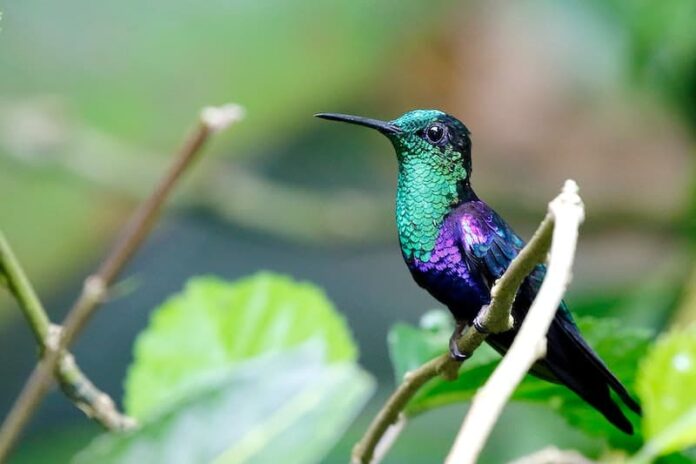Hummingbirds are so graceful their appearance and colorations are so gorgeous and magnificent to look at. There are around 338 hummingbird species in the world, but we only discuss 10 for now. Today, we are going to look at some of the most beautiful hummingbird species that might capture your hearts. We are also going to learn a thing or two about the background of each species as well. Let’s check them and see which beautiful hummingbird species below you like the most.
1Anna’s Hummingbird
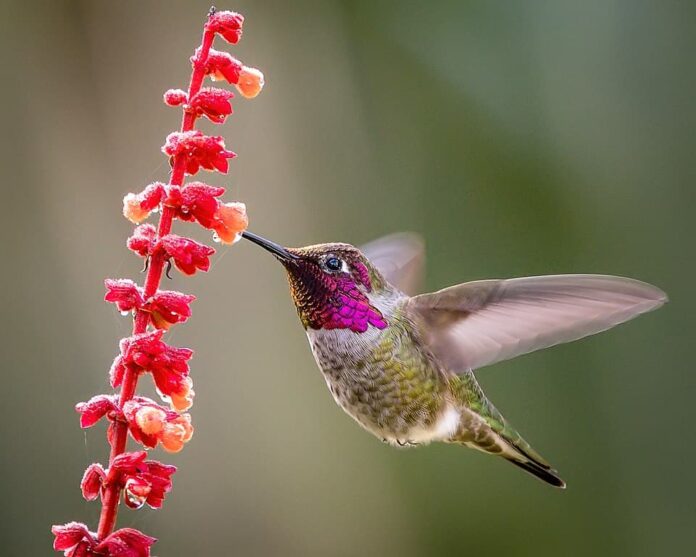
Looking very stocky, Anna’s is a medium-sized hummingbird with an iridescent bronze-green back and pale gray belly and chest. It has no orange marks or rufous on its body but the male’s head and throat are covered in iridescent reddish-pink gorget. The females also have iridescent red gorgets but they are usually smaller and less bright than males. Both sexes have a straight and short bill along with a fairly broad tail. They use that bill to feed on nectar from various flowers and catch small insects sometimes.
Anna’s hummingbirds are familiar with people so they usually come to flowering plants and hummingbird feeders to feed. Apart from living near humans, they are also common in coastal shrubs, eucalyptus groves, parks, residential streets, riverside woods, savannas, and yards. Where they live, they assist in plant pollination as pollen sticks and falls from their beaks and feathers. Their everyday flights to collect nectar transfer pollen grains to hundreds of flowers per day.
2Crowned Woodnymph
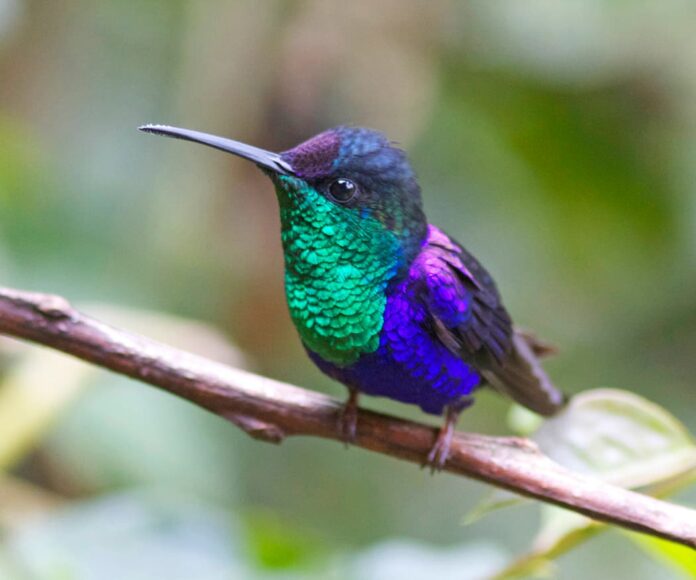
As for this beautiful hummingbird species, it is a small bird with a size of 8.5 to 11.5 centimeters. Adult males have a violet belly, crown, forehead, and upper back with dark bronzy green nape and dark-bluish green lower back and rump. Males have glittering green chests and throats, giving them a very bright and gorgeous look. For adult females, they have bright green upperparts, darker gray belly, and pale gray chest and throat. Males and females don’t live or migrate in flocks, and they only come together in the breeding season.
Crowned woodnymph also goes by the name blue-crowned woodnymph, citado woodnymph, Colombian woodnymph, purple-crowned woodnymph, and violet-crowned woodnymph. This species is found in Belize, Colombia, Guatemala, Honduras, Nicaragua, Panama, Peru, and Venezuela. They inhabit clearings, edges, and interiors of humid primary, mature secondary forests, and semi-open landscapes such as gardens and plantations. In those areas, they primarily feed on nectar from brightly colored and scented small flowers of trees, epiphytes, herbs, and shrubs. Sometimes they also drink from bird baths or water fountains, or go to hummingbird feeders for some sugar water.
3Ecuadorian Hillstar
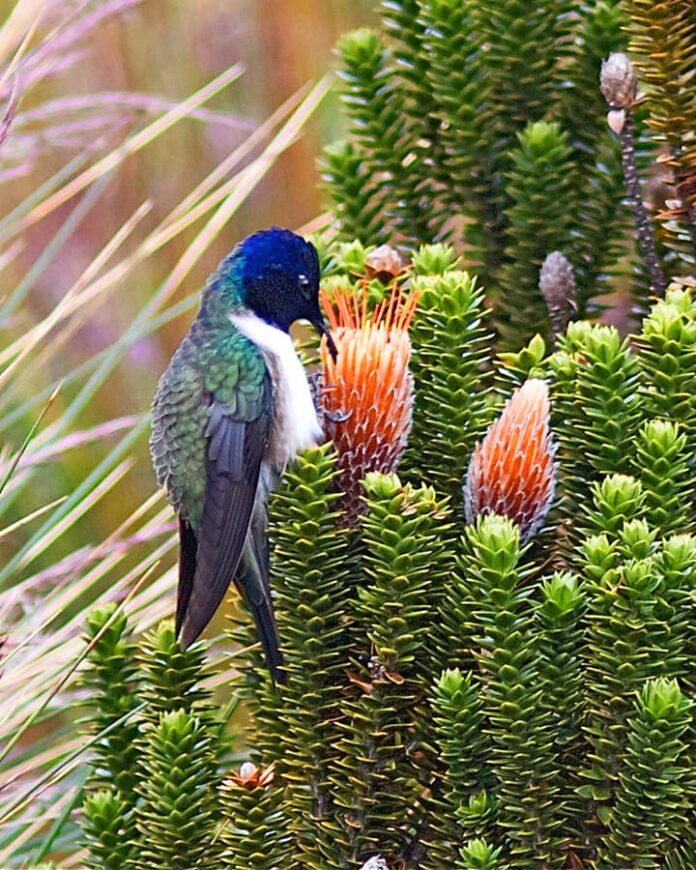
Ecuadorian hillstar aka Chimborazo hillstar is a beautiful hummingbird species native to the Andes of Ecuador and extreme southern Colombia. This bird can grow up to 12 centimeters with 2 centimeters slightly decurved black bill. Male Ecuadorian hillstars have a glittering violet purple hood and horizontal black chest stripe with dark olive green upperparts. Females have duller dusty olive green upperparts with a whitish throat speckled with brown spots.
The Ecuadorian hillstar birds have a specific food source which is the orange flowers of the Chuquiraga shrub. Another interesting thing is that they have a relatively large feed for a hummingbird, and they make great use of those feet. So instead of hovering while feeding, they land and cling to the plant to feed which saves a lot of energy. Since they live in cold areas, it is important to save their energy. These birds also build their nests in bushes, caves, or on the walls of steep ravines to protect themselves. Their nests are very large, and they build them from warm materials such as feathers, grass, horse hair, moss, and rabbit fur.
4Fiery-Throated Hummingbird
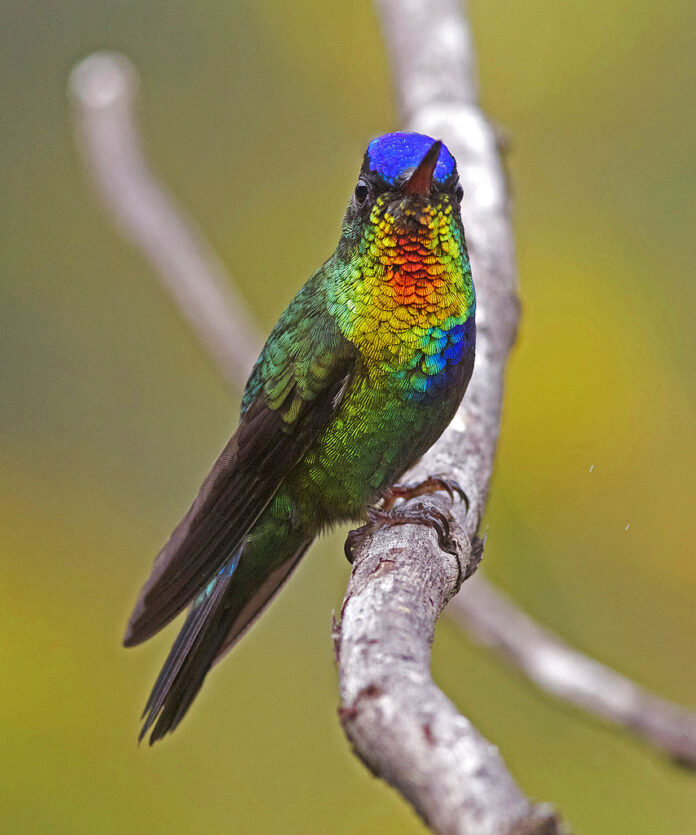
Fiery throat indeed, this magnificent bird is without a doubt one of the most beautiful hummingbird species. The bird is around 11 centimeters long, and both males and females are alike. They have a glittering blue crown while the rest of the face and nap are black. The pretty part is the bright metallic green back that becomes bluish-green on the upper tail. From the front, you can see the violet-blue patch on the center of its breast with bright green underparts.
You can find them in cloud forests, elfin forests, montane forests, pastures, and secondary forests where they live in the forest canopy. These small birds feed on nectar from various small flowers as well as shrubs and small trees. Despite the size, they are very aggressive and dominant over most other hummingbirds. The males will defend their feeding territories during the breeding season but they allow females to feed. On top of that, they even aggressively hunt other male hummingbirds or large insects like bumblebees or hawkmoths that try to feed in their territory. Clearly not something to mess with I’d say.
5Green-Crowned Brilliant
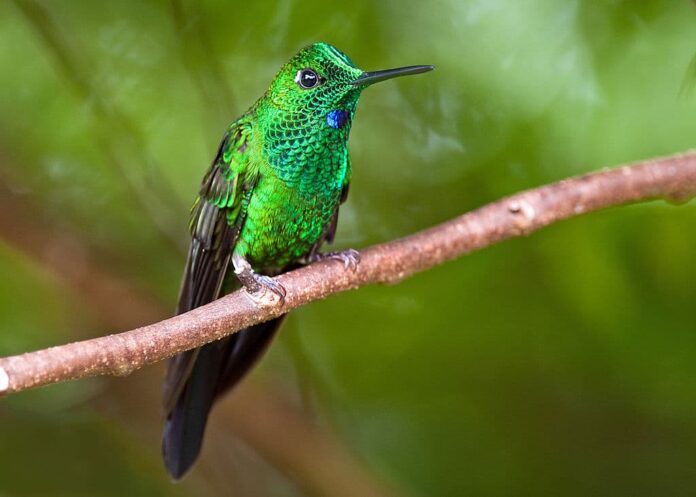
The green-crowned brilliant or the green-fronted brilliant is a medium-sized hummingbird that is 12 to 13 centimeters. Adult males of this species have glittering green to blue-green head and breast with a small metallic violet-blue on the throat. The belly and upperparts of the bird are bronzy green, and the tail is blue-black. Adult females have the same blue-green head but are not as shiny as the male.
This beautiful hummingbird species lives in a wide range of habitats such as clearings, edges, and interiors of humid montane and sub-montane forests. You can also find them in gardens and secondary forests as well. In their habitats, they feed on inflorescences of Marcgravia vines and other large flowers. The males sometimes defend the areas with flowers that they feed on but they are not too aggressive.
6Long-Tailed Sylph
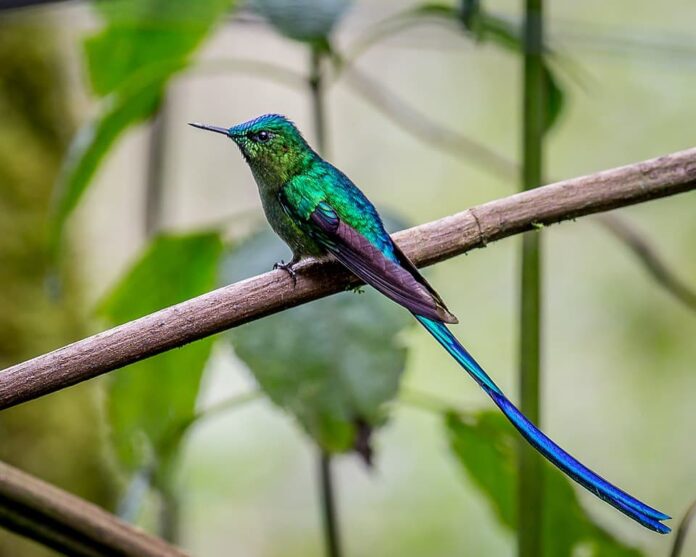
The name says it all, the is one of the hummingbird species with a long tail that is up to 12 centimeters. Actually, the long part of the tail is the out feathers, the inner tail feathers are very short. Males have a shining emerald green crown, metallic green head, metallic bronzy green upperparts, duller green underparts, and a blue or violet throat. Females have similar upperparts but they have a shorter tail while their underparts are cinnamon.
Generally, long-tailed sylph inhabits open landscapes like clearings and edges of forests, gardens, high-elevation grasslands, scrublands, and secondary forests. The fascinating part about them is how they feed on nectar, using various methods. Sometimes they hover the flowers to feed while other times they cling to them. Even more interesting, they also “rob” nectar by piercing the base of a flower. Quite cool, right?
7Marvelous Spatuletail
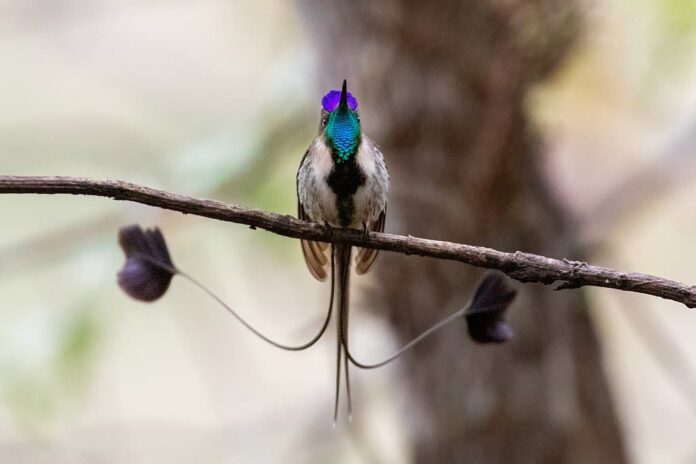
Endemic to northern Peru, the marvelous spatuletail is an endangered species of hummingbird in the “brilliants” tribe. It is a medium-sized bird that grows up to 17 centimeters along with another 11 to 13 centimeters of tail. Males have green upperparts with a blue crest and a brownish hindneck, and glossy blue-green gorget. Females also have green upperparts but the crest and gorget are absent. You can easily recognize a male by the two outer tail feathers with bare shafts that cross each other. His tail ends in large purplish racquets or “spatules”. The female’s tail is also long but shorter than that of the male, and without the racquets.
Since their population is only limited to a small area of northern Peru, coming across them is very rare. They inhabit the edges of mature forests, montane scrublands, and secondary forests. While having a declining population due to habitat loss, people who come across them didn’t take good care of them either. Local people hunted the males for their tails, and local folklore claimed that the male’s heart was an aphrodisiac. Even children would knock the birds from the air with slingshots just to have fun. At least, the locals now are protecting the, by planting native flowers that these hummingbirds feed on. Hopefully, their population will become better in the future.
8Red-Tailed Comet
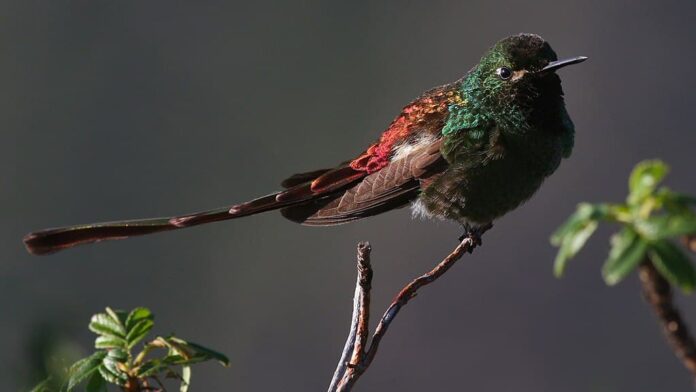
We have been talking about some of the small hummingbirds, and here you are looking at one of the largest hummingbirds. The females can grow up to 15 centimeters while males can each a length of 22 centimeters. Male red-tail comets have green head and plumage, a shining gorget, and reddish violet back and rump. Females have similar colorations but paler, and a shorter tail. This beautiful hummingbird species is found in the central Andes of Argentina and Bolivia, Chile, and Peru. They are common in moist cloud forests, scrub typical of the dry valleys in the Andes mountain, shrubby areas, and woodlands.
9Rufous Hummingbird
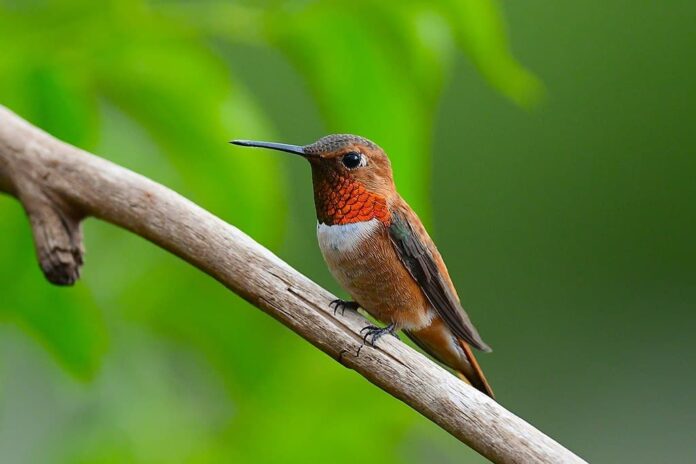
With just about 8 centimeters in size, the rufous hummingbird is a very small species. The size does not define their ability to fly, in fact, they can fly up to 3,200 kilometers during their migratory transits. More than that, they have fast darting flight along with pinpoint maneuverability which is very impressive. If we talk about beauty, a male has a rufous face, flanks, and tail along with an iridescent orange-red gorget. The female has green, white, and some iridescent orange feathers in the center of the throat.
Being so small, yet the reputation of being the most aggressive hummingbird belongs to it. Both male and female rufous hummingbirds are territorial, and their impressive flying skill allows them to chase and attack other birds to defend their territory. Males are more territorial and they fight to defend areas with defend flowers which pushes females into areas with fewer flowers. It is beneficial for them because they don’t have to forage for food since their territory provides plenty of sustenance.
Rufous hummingbirds have various habitats depending on the different times of the year. During the breeding season, they are in brushy second growth, clearings, forest edges, open areas, parks, and yards. On migration, they go to mountain meadows as high as 12,600 feet where there are blooming nectar-rich tubular flowers. When winter comes, they live in oak-pine forests and shrubby openings instead. As spring approaches, they will be more common in lowland areas.
10Velvet-Purple Coronet
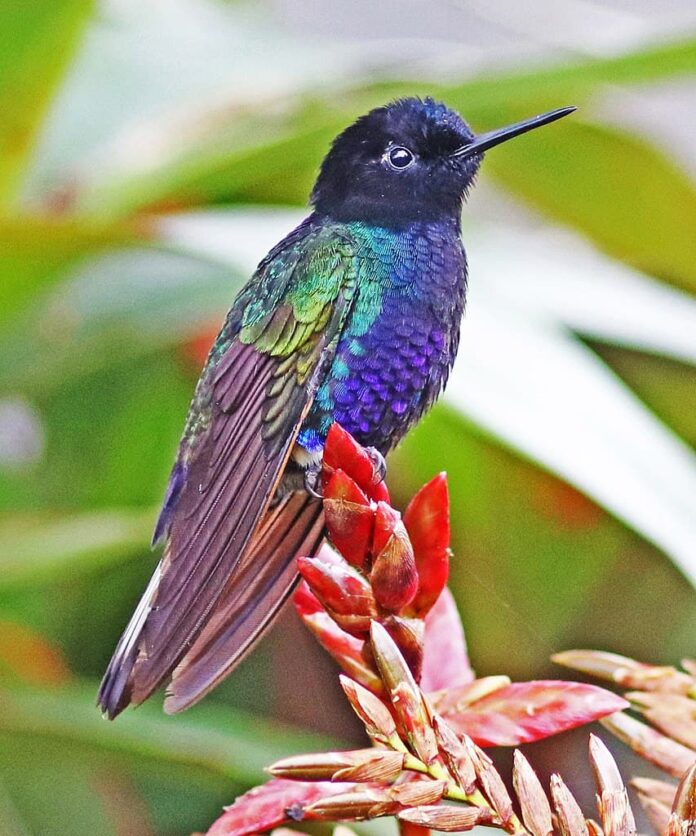
The beauty is mesmerizing in this one, and it is clear that the velvet-purple coronet is among the most beautiful hummingbird species. Its size is from 11 to 12.7 centimeters, and both sexes have a short and straight black bill. Male velvet-purple coronets have a velvety black head with a glittering purplish blue crown, and shining bluish green upperparts. Their throats are velvety black, and the breast and belly are glittering purplish blue. Females have similar colors to males but duller, and their breast and belly have buff to grayish brown fringes.
Velvet-purple coronets live in South America, mostly in north-western Ecuador and the western Andes of southwestern Colombia. Their natural habitats are subtropical and tropical wet and humid edges and forests, especially where epiphytes cover the trees. They also live in grasslands, tropical grasslands, and savannas as well. These hummingbirds favor flowers with the highest sugar content, typically flowers that are red with a tubular shape. Bees and butterflies cannot feed on flowers with that shape, so these hummingbirds play an important part in pollinating these flowers.
Related Post: Beautiful Birds Of Paradise

